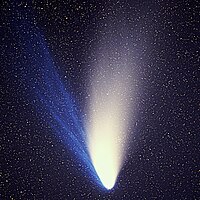Comet Hale–Bopp

Comet Hale–Bopp, shortly after passing perihelion in April 1997.
|
|
| Discovery | |
|---|---|
| Discovered by |
Alan Hale Thomas Bopp |
| Discovery date | July 23, 1995 |
| Alternative designations |
The Great Comet of 1997, C/1995 O1 |
| Orbital characteristics A | |
| Epoch | 2450460.5 |
| Aphelion | 370.8 AU |
| Perihelion | 0.914 AU |
| Semi-major axis | 186 AU |
| Eccentricity | 0.995086 |
| Orbital period | 2520–2533yr (Barycentric 2391 yr) |
| Inclination | 89.4° |
| Dimensions | 40–80 km |
| Nucleus albedo | 0.01–0.07 |
| Last perihelion | April 1, 1997 |
| Next perihelion | 4385 ± 2.0 AD |
Comet Hale–Bopp (formally designated C/1995 O1) is a comet that was perhaps the most widely observed of the 20th century and one of the brightest seen for many decades. It was visible to the naked eye for a record 18 months, twice as long as the previous record holder, the Great Comet of 1811.
Hale–Bopp was discovered on July 23, 1995, at a great distance from the Sun, raising expectations that the comet would brighten considerably by the time it passed close to Earth. Although predicting the brightness of comets with any degree of accuracy is very difficult, Hale–Bopp met or exceeded most predictions when it passed perihelion on April 1, 1997. The comet was dubbed the Great Comet of 1997.
The comet was discovered independently on July 23, 1995 by two observers, Alan Hale and Thomas Bopp, both in the United States.
Hale had spent many hundreds of hours searching for comets without success, and was tracking known comets from his driveway in New Mexico when he chanced upon Hale–Bopp just after midnight. The comet had an apparent magnitude of 10.5 and lay near the globular cluster M70 in the constellation of Sagittarius. Hale first established that there was no other deep-sky object near M70, and then consulted a directory of known comets, finding that none were known to be in this area of the sky. Once he had established that the object was moving relative to the background stars, he emailed the Central Bureau for Astronomical Telegrams, the clearing house for astronomical discoveries.
Bopp did not own a telescope. He was out with friends near Stanfield, Arizona observing star clusters and galaxies when he chanced across the comet while at the eyepiece of his friend's telescope. He realized he might have spotted something new when, like Hale, he checked his star maps to determine if any other deep-sky objects were known to be near M70, and found that there were none. He alerted the Central Bureau for Astronomical Telegrams through a Western Union telegram. Brian G. Marsden, who had run the bureau since 1968, laughed, "Nobody sends telegrams anymore. I mean, by the time that telegram got here, Alan Hale had already e-mailed us three times with updated coordinates."
...
Wikipedia
